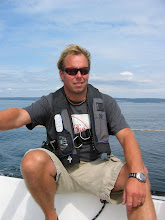

Ok..so I'm not sure if its pronounced "fillet" like what I order at a steakhouse or "fill-it"--so if someone knows, please set me straight! Anyway, however it's pronounced, I now have one on my boat. The fillet is just a smoothened bead of thickened epoxy laid in a joint where two panels come together. Tonight, I started on the keel joint. I mixed up the epoxy and thickened it with plastic fiber and microbeads. I then glopped it into a ziplock freezer bag. By snipping off a small part of the corner of the bag and then sqeezing, I was able to lay a nice controlled bead. I then shaped it with a radiused putty knife making a nice smooth consistent bead. After this started to set up slightly, I put a 3" wide layer of cloth down. Unfortunately, I didn't make it to the fiberglass place to pick up 3" tape so I cut a 3" x 25' long strip. As I wet out this strip of cloth, the cut edge started fraying and causing a bunch of work to keep it from being a mess. I got the edge cleaned up but from now on will only use the glass "tape" to avoid the fraying edge. I then layed a 6" tape over the 3" to give me two layers of cloth over the fillets. Once again I used papertowels over the whole laminate and then rolled it. This soaked up any excess resin and gave me a nice tight, consistent finish. Turned out really nice and should be very strong.











